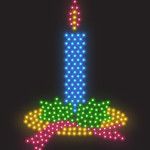By: G. M. Filisko
LED holiday lights vs. old-fashioned bulbs: 6 tips to help you decide which is right for you. 
Should you chuck all your good old holiday light strings and buy new LED holiday lights? Here’s how to decide.
1. LED holiday lights save you money. LED lights use up to 90% less energy than traditional holiday lights, according to the U.S. government’s Energy Star program.
That results in a $50 energy savings for the average family during the holidays, says a Sierra Club spokesperson.
Put it into perspective: The amount of electricity consumed by one 7-watt incandescent bulb (in a light string) could power 140 LEDs — enough to light two 24-foot strings, says Energy Star.
2. But LED lights typically cost more than old-fashioned holiday lights.
- 100-bulb string of LED lights: about $20 to $46
- 100-bulb string of conventional lights: about $7 to $12
But shop around because LED prices are coming down. And you’ll likely find sales on LED holiday lights — if not before the holidays then certainly after.
3. LED holiday lights last and last. LED bulbs can keep your season bright for as long as 100,000 hours, says Cathy Choi, president of Moonachie, N.J.-based Bulbrite, which manufactures LED and regular bulbs. That’s substantially longer than the life of your old holiday light strings.
4. You can string a BIG strand of LED lights. Safety wise, you shouldn’t connect more than three traditional light strings, but you can connect up to 87 LED holiday light strings, totaling a whopping 1,500 feet, Choi says. So blow your neighbor’s display away by cocooning your house in lights:
- You won’t have to buy as many extension cords.
- You can take your holiday lighting display further away from the outlet.
5. LED lights reduce the risk of fire. They stay cooler than incandescent bulbs, according to Energy Star.
6. How about that hue? Some people stick with their old lights because they don’t like the brighter hue that white LED holiday lights emit. But Choi says manufacturers now offer a “warm white” bulb that more closely mimics the glow of an incandescent light. Be sure to read the label to choose a bright or warm white and to ensure what you’re purchasing is Energy Star-certified.
Colored and color-changing LED holiday lights are more vibrant than conventional lights, making your display easier to see from the street, Choi says.
Visit HouseLogic.com for more articles like this. Reprinted from HouseLogic.com with permission of the NATIONAL ASSOCIATION OF REALTORS®.